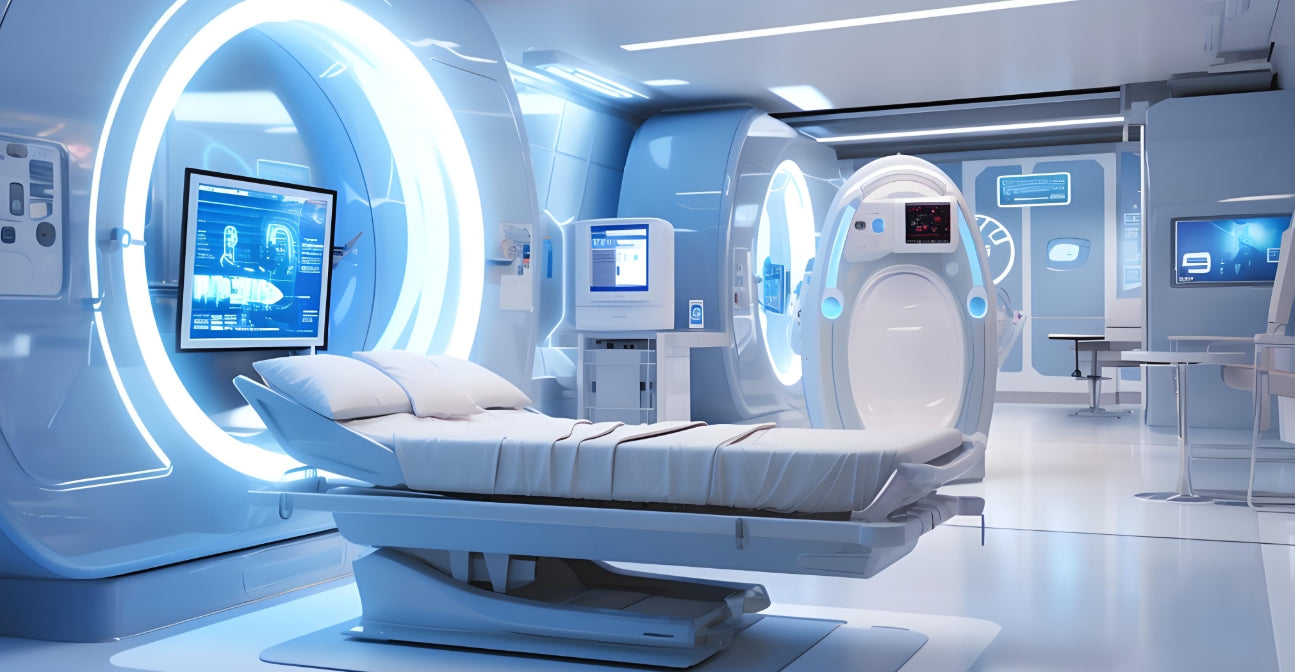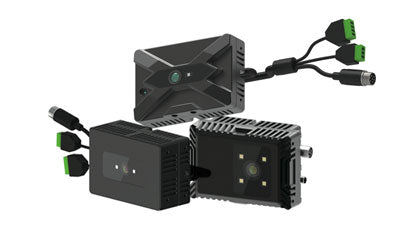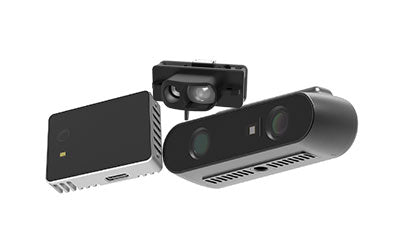TOF Empowers Next-Gen Medical Devices & Contactless Vital Monitoring

In the post-pandemic era, the healthcare industry has seen a growing demand for contactless technologies, especially in intensive care, infectious disease control, and telemedicine scenarios. Non-invasive, low-risk physiological signal acquisition methods are rapidly becoming mainstream. As a next-generation core 3D sensing component, the Time-of-Flight (ToF) camera is injecting powerful capabilities into modern medical devices.
What is a ToF camera used for?
A ToF (Time-of-Flight) camera is a 3D imaging device that captures depth information by measuring the time it takes for light to travel to and from an object. It features real-time imaging, strong anti-interference, and low latency. Its major applications include:
-
Gesture recognition and body motion capture: Enables gesture control and motion tracking in smartphones, gaming devices, and interactive displays.
-
Facial recognition and security monitoring: Enhances accuracy in applications such as access control, facial payment, and surveillance.
-
Robot navigation and obstacle avoidance: Provides precise 3D spatial perception for service and industrial robots.
-
Smart home and device control: Enables touch-free interaction by detecting posture for lighting, audio, and other appliances.
-
Healthcare monitoring: Supports posture analysis, sleep monitoring, and fall detection in health applications.
-
Smart cultural tourism: Enables visitor tracking, behavior analysis, heatmaps, and virtual interaction, improving visitor experience and operational efficiency.
ToF cameras are widely applicable in scenarios that require high-precision depth sensing and real-time interaction.
High Demand for Contactless Technology in Medical Settings
As such, contactless sensing systems equipped with ToF 3D cameras have become an essential part of smart hospital upgrades. These systems detect subtle surface movements of the human body to monitor heart rate, respiratory rate, posture changes, and abnormal movements in real time. Compared to traditional patch-based monitoring, ToF-based solutions eliminate problems such as electrode detachment and cable entanglement, significantly reducing nursing workloads.
In ICUs, this technology enables continuous, uninterrupted monitoring of critical patients' vital signs without disturbing their rest. In neonatal intensive care units (NICUs), it avoids risks of skin damage and infection. For quarantine zones dealing with highly infectious diseases like COVID-19, it offers clear advantages—remote, contactless monitoring of vital signs reduces the risk of exposure for healthcare workers.
Moreover, ToF 3D cameras can integrate seamlessly with hospital information systems for automatic data uploading, trend analysis, and alert notifications. This lays a technological foundation for building 'smart wards' and 'digital ICUs.' As a result, contactless monitoring is gradually becoming a standard system for future medical environments, helping hospitals become safer, more efficient, and more patient-centric.
How Does ToF Technology Detect Respiration and Heart Rate?
ToF technology emits near-infrared light and measures the return time of the light pulses to construct millimeter-precision depth maps that capture subtle body surface movements in real time. This principle provides a solid foundation for contactless vital sign monitoring and is driving a shift from wearable to visual monitoring.
Examples include:
-
Respiratory Rate Monitoring: As patients breathe, their chest and abdomen rise and fall rhythmically. These movements appear as periodic deformations in ToF depth maps. By extracting depth variations from specific regions and applying Fourier or time-domain analysis, respiratory rate can be calculated accurately, and conditions like apnea or shallow breathing can be detected.
-
Heart Rate Monitoring: Although the body surface displacement from heartbeat is much smaller than that of breathing (typically around 0.1 mm), improvements in ToF sensor resolution and frame rate enable detection of these micro-movements. By sampling the chest or carotid artery regions with high precision over space and time, ToF systems can achieve contactless heart rate monitoring, making them suitable for critical care and neonatal monitoring.
-
Posture Monitoring and Fall Detection: ToF 3D systems capture full-body pose information. AI models analyze this to determine whether a patient is lying, sitting, getting up, leaving bed, or has fallen. Alerts can be triggered for long periods without repositioning, unauthorized movement, or dangerous behavior, helping caregivers intervene promptly and reduce risk events like bedsores and falls.
Compared with traditional 2D vision, ToF 3D cameras offer key advantages:
-
Strong resistance to environmental interference: As active light-emitting devices, they are independent of ambient lighting, and can deliver reliable depth data even in dark, low-light, or backlit environments.
-
High precision and wide field of view: ToF provides panoramic sensing with millimeter-level accuracy, ideal for comprehensive bed-area monitoring.
-
Rich data suitable for AI integration: Depth and spatial information facilitate multimodal AI analysis and intelligent decision-making.
ToF technology enables accurate monitoring of vital signs such as respiration and heart rate, while expanding capabilities in posture and behavior detection. It shows significant potential in contactless intelligent medical care.
Applied in ICUs, Neonatal Monitoring, and Telemedicine Terminals
With its high precision, real-time capabilities, and non-invasive nature, ToF-based contactless sensing is being widely adopted in key medical scenarios, helping to build a smarter, gentler, and more efficient healthcare system. Typical use cases include:
-
ICU Monitoring: In ICUs, patients are often critically ill and immobile. Traditional monitoring relies on multiple wearable or contact-based sensors like ECG patches and posture sensors. While accurate, these devices can cause discomfort and pose infection risks. By installing ToF depth cameras above beds or in corners, medical staff can track chest movement and patient repositioning in real time, monitoring respiratory rate, movement, and posture without physical contact. This reduces patient discomfort and improves nursing response efficiency.
-
Neonatal Monitoring: Newborns have delicate skin and are sensitive to adhesive monitoring devices, which can cause allergic reactions, blisters, or peeling. ToF 3D sensing replaces these with a gentler solution, continuously tracking breathing, micromovements, and repositioning without disturbing the infant’s rest or comfort. It also provides early warnings for choking or positional asphyxiation, offering enhanced protection for preterm or weak infants.
-
Remote Healthcare and Home Health Terminals: As remote care and home health monitoring rise, many households are installing smart health devices. ToF-powered smart bedside units, respiration monitors, or elderly care systems can automatically track heart rate, breathing, turning, and getting out of bed during sleep or rest. Key data is transmitted via IoT to medical platforms for remote analysis, health assessments, or abnormal alerts by doctors or AI. These solutions are especially suitable for chronic disease management, elder care, and monitoring of people living alone.
In the future, as ToF technology merges further with AI, its applications will expand into post-operative monitoring, mental state assessment, and rehabilitation training, becoming an essential infrastructure for next-gen zero-contact medical sensing networks. It not only reduces the burden on healthcare workers but also delivers safer, more gentle, and intelligent healthcare experiences for patients.
AI Integration: Building a Proactive Health Warning System
With the deep integration of AI technology, TOF (Time-of-Flight) devices have evolved beyond their role as mere 'sensors' to become core perception nodes in proactive health management systems. These devices no longer just capture static 3D depth data but now acquire dynamic data streams that reflect changes in human physiological states. Empowered by AI algorithms, this data is transformed into predictive, analytical, and actionable smart services, advancing medical scenarios toward a new paradigm of prevention-first, proactive response, and intelligent collaboration.
-
AI Trend Analysis and Behavior Modeling: By feeding long-term recordings from TOF cameras—such as breathing rate, body movement frequency, and turning patterns—into custom AI solutions, the system can automatically build personalized health models for each patient. When an indicator (e.g., shallow breathing, drastic drop in turning frequency, abnormal bed exit) deviates from historical trends, the system will automatically flag it as a potential risk event, providing early data support for clinical intervention.
-
Health Risk Alert System: By combining AI image recognition with deep learning models, even subtle changes captured by TOF can be converted into semantic-level health event detection (e.g., risk of suffocation, falls, or prolonged immobility). The system can automatically push alerts to nurse stations, physician terminals, or home care apps, enabling 24/7 low-latency remote health monitoring, significantly improving emergency response efficiency.
-
Integration with ROS Platform to Enable Intelligent Medical Robots: By combining TOF sensing with mainstream robotics platforms such as ROS (Robot Operating System), developers can build smart ward-round robots and companion robots for hospitals and eldercare facilities. These robots can autonomously navigate, monitor patient conditions in real time, send alerts when abnormalities occur, and upload relevant data to hospital information systems (HIS) or cloud-based health records—creating a truly 'visible, controllable, and collaborative' intelligent care ecosystem.
As TOF technology continues to advance and infrastructure like edge computing, 5G, and cloud-based AI matures, TOF+AI health monitoring systems will achieve even higher levels of real-time responsiveness and intelligence. Whether in hospital ICUs, home care environments, senior living facilities, mobile medical units, or remote health management platforms, a data-driven, AI-powered 'proactive health alert network' is emerging—safeguarding lives and continuously empowering the future of smart healthcare.
The Development and Compliance Challenges of Medical-Grade TOF Sensors
As TOF (Time-of-Flight) sensor technology advances toward medical-grade applications, it is undergoing a significant leap from 'consumer-grade' to 'medical-grade.' This transformation goes beyond hardware performance upgrades; it requires systematic control over compliance, safety, and data integrity. To be viable in critical medical settings—such as ICUs, neonatal monitoring, or remote patient care—TOF sensors must overcome strict challenges across multiple dimensions.
1. Breakthroughs in Precision and Architecture
Consumer-grade TOF sensors often use structured light or indirect TOF (iTOF), sufficient for general depth sensing. However, in medical environments—where micron-level surface fluctuations such as heartbeat or subtle body movements must be detected—high-performance Direct TOF (DTOF) architectures are required. These use high-speed laser emitters paired with low-noise, high-dynamic-range SPAD (Single Photon Avalanche Diode) arrays to achieve sub-millimeter resolution and superior signal-to-noise ratios (SNR) for real-time depth sensing.
2. Chip-Level Reliability and Durability Design
Medical applications demand far greater reliability from TOF sensor semiconductor chips than even industrial-grade devices, including:
-
Heat resistance, EMI shielding, and multi-year lifespan, suitable for frequent data collection and continuous operation;
-
Consistent high sensitivity in extreme environments, such as low-light patient rooms or high-humidity neonatal incubators;
-
On-chip temperature compensation and auto-calibration mechanisms to ensure long-term accuracy and performance stability.
3. Regulatory Compliance and Data Privacy Protection
To be included in medical equipment, TOF sensors must comply with multiple global certification standards, such as:
-
FDA Class II medical device registration (U.S.) to verify safety and effectiveness;
-
CE MDR certification (Europe) for legal circulation in the European market;
-
Compliance with HIPAA (Health Insurance Portability and Accountability Act), GDPR, and other regulations to ensure patient data privacy and protection.
Additionally, TOF data processing must support strict traceability and clinical validation consistency, ensuring data can be used for diagnostic assistance and integration into electronic medical records.
4. AI Edge Computing and On-Device Deployment
Medical-grade TOF sensors are often paired with high-performance AI edge modules (e.g., NVIDIA Jetson series, ARM A76-based SoCs) to perform tasks like breathing rate estimation, posture detection, and heart rate extraction locally, enabling:
-
Millisecond-level responsiveness, avoiding latency caused by remote servers;
-
Local data processing and encrypted storage, reducing the risk of interception or leakage during transmission;
-
Support for OTA (Over-the-Air) remote updates and model optimization, enhancing system longevity and maintainability.
5. Toward a Collaborative Ecosystem of Precision Sensing and Intelligent Diagnosis
As TOF medical sensors evolve, several core technologies are being integrated into their ecosystem:
-
Precision sensors: Simultaneous integration with temperature, humidity, acoustic, and heartbeat sensors to build multi-dimensional health monitoring systems;
-
Measurement technologies: Fusion with traditional medical devices like pulse oximeters, blood pressure monitors, and ECG machines to achieve hardware-software synergy;
-
AI Custom Models: Tailored recognition logic for different populations (e.g., neonates, the elderly, patients with chronic diseases), improving clinical adaptability.
The evolution of medical-grade TOF sensors is no longer limited to 'sharper 3D imaging,' but is advancing toward becoming a clinically reliable proactive health sensing system. Through hardware-software co-design, closed-loop compliance management, and intelligent AI support, TOF is emerging as a foundational force in the smart healthcare revolution—enabling contactless health monitoring to enter core medical scenarios and serve broader populations and conditions.
Conclusion: TOF Technology Drives a New Era of Medical Sensing
Transitioning from 'passive detection' to 'active sensing,' TOF technology enables a genuine smart upgrade of medical devices. It not only simplifies patient monitoring and improves data acquisition accuracy and efficiency, but also opens up new possibilities for medical robotics, remote diagnostics, and intelligent wards.
With the growth of the 3D sensing market and advances in semiconductor chip technologies, TOF is set to play an increasingly vital role in future medical equipment—becoming the core 'eye' of intelligent medical perception systems.
Synexens 3D Of RGBD ToF Depth Sensor_CS30
Our professional technical team specializing in 3D camera ranging is ready to assist you at any time. Whether you encounter any issues with your TOF camera after purchase or need clarification on TOF technology, feel free to contact us anytime. We are committed to providing high-quality technical after-sales service and user experience, ensuring your peace of mind in both shopping and using our products.





